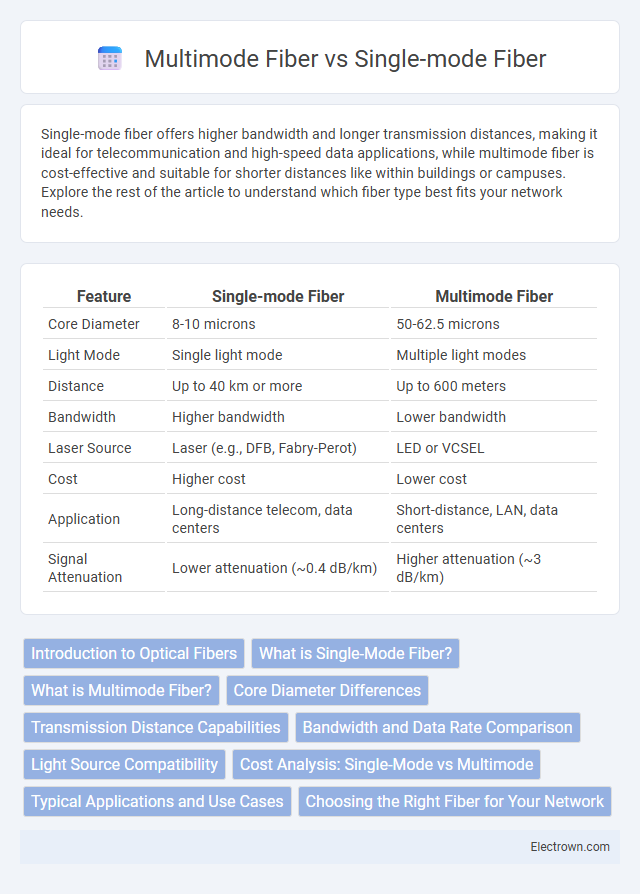Single-mode fiber offers higher bandwidth and longer transmission distances, making it ideal for telecommunication and high-speed data applications, while multimode fiber is cost-effective and suitable for shorter distances like within buildings or campuses. Explore the rest of the article to understand which fiber type best fits your network needs.
Table of Comparison
| Feature | Single-mode Fiber | Multimode Fiber |
|---|---|---|
| Core Diameter | 8-10 microns | 50-62.5 microns |
| Light Mode | Single light mode | Multiple light modes |
| Distance | Up to 40 km or more | Up to 600 meters |
| Bandwidth | Higher bandwidth | Lower bandwidth |
| Laser Source | Laser (e.g., DFB, Fabry-Perot) | LED or VCSEL |
| Cost | Higher cost | Lower cost |
| Application | Long-distance telecom, data centers | Short-distance, LAN, data centers |
| Signal Attenuation | Lower attenuation (~0.4 dB/km) | Higher attenuation (~3 dB/km) |
Introduction to Optical Fibers
Optical fibers transmit data as light pulses, with single-mode fiber supporting a narrow core diameter around 8-10 microns, enabling long-distance communication with minimal signal loss and high bandwidth. Multimode fiber features a larger core, typically 50-62.5 microns, allowing multiple light modes to propagate, which suits shorter distances due to modal dispersion. Both fiber types use glass or plastic cores, but their design differences directly impact bandwidth capacity and transmission distance in telecommunication and networking applications.
What is Single-Mode Fiber?
Single-mode fiber is an optical fiber designed to carry light directly down the fiber with a single propagation mode, enabling high bandwidth and long-distance data transmission. It features a small core diameter, typically around 8 to 10 microns, which minimizes modal dispersion and supports wavelengths mostly at 1310 nm and 1550 nm. Commonly used in telecommunications and high-speed internet networks, single-mode fiber is ideal for distances exceeding 10 kilometers.
What is Multimode Fiber?
Multimode fiber is an optical fiber designed to carry multiple light modes or signals simultaneously, typically used for short-distance data transmission within buildings or campuses. It features a larger core diameter, usually 50 or 62.5 microns, allowing multiple rays of light to propagate, which simplifies alignment but limits bandwidth and increases modal dispersion. Commonly utilized in local area networks (LANs) and data centers, multimode fiber supports high-speed communication over distances up to 2 kilometers with laser or LED light sources.
Core Diameter Differences
Single-mode fiber features a core diameter of approximately 8 to 10 microns, enabling light to travel straight through the fiber with minimal dispersion, ideal for long-distance communication. Multimode fiber typically has a core diameter ranging from 50 to 62.5 microns, allowing multiple light modes to propagate simultaneously, which limits bandwidth and distance. The smaller core of single-mode fiber provides higher bandwidth and lower attenuation compared to the larger core of multimode fiber.
Transmission Distance Capabilities
Single-mode fiber supports transmission distances up to 40 kilometers or more with minimal signal loss, making it ideal for long-haul telecommunications and high-speed data networks. Multimode fiber typically handles distances up to 550 meters due to modal dispersion, which limits its use to shorter-range applications like data centers and local area networks. The core diameter of single-mode fiber is approximately 8-10 microns, significantly smaller than multimode fiber's 50 or 62.5 microns, contributing to its superior distance capabilities.
Bandwidth and Data Rate Comparison
Single-mode fiber offers significantly higher bandwidth and longer distance capabilities compared to multimode fiber, making it ideal for high-speed data transmission in telecommunications and data centers. Multimode fiber supports lower data rates and shorter transmission distances due to modal dispersion, which limits its effectiveness for large-scale network infrastructure. Your choice depends on the required data rate and distance; single-mode fiber excels in environments demanding superior bandwidth and minimal signal loss.
Light Source Compatibility
Single-mode fiber is compatible with laser light sources operating at wavelengths of 1310 nm and 1550 nm, enabling long-distance and high-bandwidth communication with minimal signal attenuation. Multimode fiber utilizes LED or VCSEL light sources, typically at 850 nm and 1300 nm, supporting shorter transmission distances and lower cost applications. Your choice of fiber should align with the light source technology to optimize network performance and reliability.
Cost Analysis: Single-Mode vs Multimode
Single-mode fiber generally incurs higher initial installation costs due to the precision required for connectors and transceivers but offers lower long-term maintenance expenses owing to its extended reach and higher bandwidth capacity. Multimode fiber typically presents a more cost-effective solution for shorter distances, with less expensive cabling and components but can lead to increased costs in larger networks due to modal dispersion and limited bandwidth. Evaluating the total cost of ownership between single-mode and multimode fibers depends on network scale, required distance, and data transmission speeds, with multimode favored for localized setups and single-mode optimal for expansive, high-performance infrastructures.
Typical Applications and Use Cases
Single-mode fiber is predominantly used in long-distance telecommunications, high-speed data networks, and cable television systems due to its low attenuation and high bandwidth capacity. Multimode fiber is ideal for shorter distances such as within data centers, LANs (Local Area Networks), and enterprise networks because of its cost-effectiveness and ease of installation. Data centers often deploy multimode fiber for server interconnects, while telecommunications providers rely on single-mode fiber for backbone infrastructure and metro networks.
Choosing the Right Fiber for Your Network
Single-mode fiber provides higher bandwidth and longer transmission distances, making it ideal for long-haul and high-speed network applications, while multimode fiber is best suited for shorter distances and cost-effective installations. Your choice depends on network requirements such as distance, bandwidth needs, and budget constraints. Selecting the right fiber ensures optimal performance, future scalability, and minimal signal loss in your network infrastructure.
Single-mode fiber vs Multimode fiber Infographic

 electrown.com
electrown.com